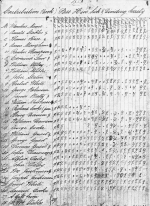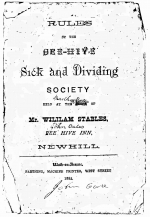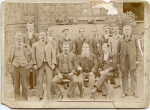The Stables Publicans and Innkeepers
After his second marriage in 1865, James Stables (b.1827, Newhill) left the coal mining industry and went into the licenced trade, when he took the tenancy of The Beehive Inn in Newhill.
James's younger brother Charles Stables (b.1830, Newhill) was the first in the family to turn to the licensing trade, but his brother soon followed him and it is apparent that this period saw a fairly general move by the family into this trade.
Three of James' sons: Charles, William and Oswald, became publicans, as did his step-son, Luke Barber, his brother Charles and his nephews Sam and George. Later his grandson, Albert, became the landlord of The Crown Inn at Newhill.
The men were not the only ones to go into this business. James's daughter Ann married John Thomas Turner, who was licensee at The Prospect Tavern Beerhouse from 1891 to 1906 and his brother Charles' daughter, Ellen, married Joseph Gomersall, and ran several public houses, including the Blue Bell Hotel at Hemsworth. His other brother, William's daughter, Mary, married Wilfred Winstanley, and they ran the New Inn, Wath, for almost 30 years.
Premises
Some of the premises they ran between them, during the course of their lives, were:
The New Inn Wath The Star Inn Wath The Cross Keys Hotel Wath The Manvers Main Inn Wath The Beehive Inn Newhill The Crown Inn Newhill The Don Hotel Swinton The Queen's Hotel West Melton The Prospect Tavern Hoyland The Rising Sun Darfield
This information in this section of the web-site was taken from biographies written by Victor Stables and it is with the permission of his cousin, Michael Chance, that I include it here.
While William was landlord of the Beehive Inn, he started the Beehive Sick and Dividing Club, the cover and first page of which are illustrated here (by kind permission of the Wath Community History Group)
The last member of the Stables family to be landlord of the Beehive Inn was Charles' son George William. He later ran the Travellers' Rest in Swinton. In this article in the Mexborough and Swinton Times from 21st January 1927, he recalls life in Newhill when he was a boy."VANISHED INDUSTRIES
When Newhill was a Beehive.
RECOLLECTIONS OF AN INNKEEPER.
There are few men in the district, probably, who are better acquainted with the history of their neighbourhood than Mr George Wm Stables, the licensee of the “Travellers’ Rest” Inn, Swinton. Mr Stables is not an old man – he is barely 60 – but he is a member of a family that has been settled in this district for three or four centuries, probably longer, but its connection with the neighbourhood can be traced for many generations. The Stables family are represented in many parishes around here, and particularly at Wath, where they have been a noted pottery, farming, and innkeeping family. At one time there were five members of the family holding inn licences in Wath alone.
Mr Stables, in the course of a chat with a representative of this newspaper, recalled that Newhill, now an unimportant hamlet, was less than 60 years ago the busiest and most prosperous part of Wath. It had its pottery, brickworks, and colliery. The pottery was owned by Messrs Dibb and Coulter, and the old pottery buildings still survive as dwellinghouses. A daughter of Mr Coulter was the first person to be buried in the cemetery at Wath, and the second burial there was that of William Cresswell a noted local character known as “Cottonball Billy,” who built the Cresswell Arms, in Bowbroom, Swinton. Mr Stables’s grandfather was manager of the Newhill pottery, and, incidentally, the founder of the Co-operative Society at Castleford.
The brickworks were situated at the bottom of Dawson’s lane, which leads to Abdy Farm. The colliery was close by the pottery, and was worked long before the Manvers Main and Wath Main collieries were sunk. Most of the houses in Newhill are over 200 years old, and the newest were built 50 years ago. Newhill also had a mill at one time, situated in Mill lane, leading to Grange Farm. It was afterwards used for the manufacture of “children’s preservatives,” and still later for the manufacture of soap. The old Newhill colliery closed down about 1874, and a new shaft was sunk in Newhill lane, near the present cemetery. This was worked until 1886, when trouble arose over the lease, and it was abandoned shortly afterwards. An uncle of Mr Stables was manager, and Shaw and Whitfield were the proprietors. The coal worked was the “Bright” seam, found at a depth of 101 yards. The same seam was recently opened and is now worked at Manvers Main. The brickworks and the pottery did not long survive the colliery, the brickworks being the last to go, and this was the end of Newhill’s “industrial era.” Some years before, Wath had become a coal mining centre of much greater importance. The Manvers Main Colliery Company had sunk their No 1 shaft in 1869 and their No 2 shaft in 1874. The Wath Main Colliery was down to coal in 1876.
Brewing was also among the industries which flourished for a time at Newhill, and there were two public-houses there. One of these, the “Beehive,” was in the occupation of the Stables family for about 35 years. There was also a lodging house at Newhill which was large enough to accommodate 42 navvies. Newhill, fifty years ago, was a famous rendezvous for poachers operating between Wentworth and Askern. They worked in co-operation, and sent loads of rabbits to the markets round about. It was also a recognised camping ground for gypsies and other vagrants.
Mr Stables recalls the old “barnstorming” days of the theatrical pioneers of this district, notably the Livesey family, who built the Prince of Wales Theatre at Mexborough, and he remembers their giving a show in a wooden theatre at Town End, Wath, called “Ten Nights in a Bar Room.” Swinton was once a great sporting centre, much frequented for running, prize fighting, horse racing, and rabbit coursing. A favourite coursing ground used to be “Hyde Park,” where the Swinton sewage farm now is, and in comparatively recent times the police have rounded up as many as 150 “sports” in a gambling raid on that ground. Some good racehorses have been bred and trained at Swinton, the most famous of them being “Tommy Tittlemouse,” one of Fred Archer’s mounts, and one of the best horses in the year 1886.
As mentioned last week, the “Travellers’ Rest,” of which Mr Stables is the landlord, was often visited by Charles Peace, whose talent for entertainment was a source of great delight to the unsuspecting customers."




